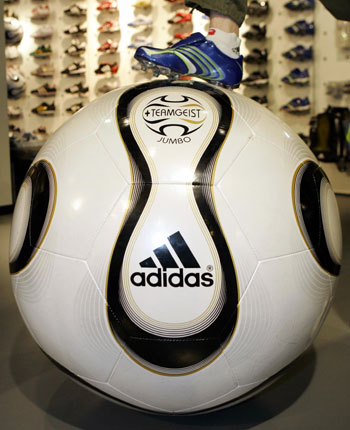Along the streets of Germany's financial center, and one of the 12 venues for
this year's World Cup, images of Ronaldhino, Zinedine Zidane and Freddie
Ljungberg entice shoppers to buy shoes, T-shirts and more soccer products.

A shop assistant
wearing an adidas soccer boot poses with a giant adidas soccer ball in a
Munich sport store May 10, 2006. [Reuters] |
The players, who wear equipment made by Nike, Adidas and Puma, respectively,
are the public faces in a fierce fight for the money and loyalty of soccer fans
worldwide. Ahead of the World Cup, with its estimated 3 million visitors and
millions more watching the 64-game tournament live on television worldwide, the
companies are working to ensure that when consumers think soccer, it's their
company that comes to mind.
Adidas AG has the edge, given that it is an official FIFA sponsor, a role it
has had since 1970, and looks to continue this year.
Matthew Lalin, executive vice president of the New York-based Steiner Sports
Marketing, said that despite Adidas' role as a World Cup sponsor will guarantee
it wide exposure, Nike and Puma are not about to be relegated to the bench.
"Call it guerrilla marketing or ambush marketing, they're going to ambush the
hell out of this thing," he said by phone from his office in New Rochelle, New
York.
Given the reach of the World Cup, companies who are official sponsors, and
those that are not, are eager to reach billions of possible consumers.
Lalin said that even though Adidas has the official sponsorship from FIFA,
neither Puma AG nor Beaverton, Oregon-based Nike Inc., will let the chance to
pitch their products slip through the net.
"You get the content in the arenas and in the stadiums as an official
sponsor, but we all know this is a star game. The World Cup is team oriented,
but at the end of the day, who ever scores the winning that goal that's what's
going to be on Sports Center," he said.
Which is why Puma, Nike and Adidas are focusing, almost in a precision way,
on the teams they sponsor.
Nike counts defending champion Brazil among its roster, along with the United
States, Portugal, the Netherlands, Mexico, Croatia, South Korea and Australia.
For Nike, it's a big change, given that it only began making uniforms for teams
for the 1998 World Cup in France.
And much like its marquee athletes, Nike is bringing the focus on to its
World Cup stars, including Brazil's Ronaldhino and Ronaldo; England's Wayne
Rooney and France's Thierry Henry.
Nike is also using the Web to tout its teams and players, along the more
traditional methods of advertising. It has a Web site, www.joga.com, that it
formed with Google that lets soccer fans form global networks in a virtual
village inhabited by its trademark Swoosh and its players. There are even
downloadable video podcasts featuring its star players.
Nike's soccer related revenue has increased from about US$40 million annually
to now nearly US$1.5 billion, according to the company.
By focusing on the athletes, as well as the team, Nike, like Puma and Adidas,
can reap more publicity, said Lalin, despite the World Cup being a team event.
"When Michael Jordan received his gold medal for basketball, he covered up
the Reebok sign on the uniform with an American flag," he said of the Nike star
and basketball legend. "That was an ultimate in your face."
It's also a way to shift focus on Nike, which has 30 percent of the world's
athletic apparel market, at the expense of Adidas, which has 35 percent.
"I think the sneaker war and the apparel war has gotten ugly, but competition
has gotten good for the industry," Lalin said.
Puma, which has only 9 percent of the global market, is the tailor of choice
for Italy, Poland, Paraguay, the Czech Republic and Switzerland, as well as
Angola, Ghana, Iran, Togo, Saudi Arabia and Tunisia. England and Sweden use
Umbro, while Ukraine and Serbia-Montenegro wear uniforms made by Lotto. Ecuador
and Costa Rica use Marathon and Joma, respectively.
Herbert Hainer, chief executive of the Herzergonerauch-based Adidas AG, whose
three-stripe logo is familiar to soccer fans, said this year's tournament is a
chance for the company, which sealed a US$3.5 billion deal to acquire
Massachusetts-based shoemaker Reebok, to expand its presence not just globally,
but in its home market.
"The World Cup is definitely a once-in-a-lifetime opportunity for Adidas,
because it's in Germany. Germany is, by far, our biggest market," he told The
Associated Press. "This is a market where we have a market share which is more
than double the size of our main competitor's."
The company is providing kits for numerous teams, blitzing its stores with
World Cup-related advertising touting its long affiliation with the sport of
soccer and its German heritage. Besides providing the kits for six teams,
including host Germany and neighboring France, Adidas' name will be found inside
the 12 stadiums that are hosting the event, unlike Puma or Nike.
The company has also outfitted Argentina, Spain, Trinidad and Tobago, as well
as Japan.
"We will sell more than 1.5 million jerseys for the teams which we will
outfit, and this altogether will bring us over the euro1 billion revenue mark,"
he said, adding that sales of its soccer balls designed for the tournament will
likely surpass euro10 million.